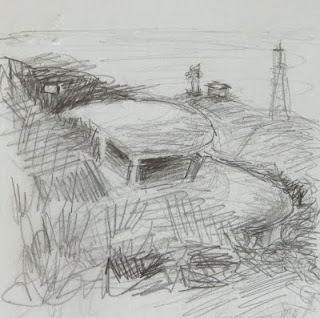This is part of the path that winds its way along the tidepool shore, down below the lighthouse. The path itself is such a beautiful thing; up and down, back and forth. The maintenance of the path is also an important part of arresting the erosion of these fragile sandstone cliffs. Out to sea, there's a clear view of that vast (and vastly important) kelp forest.
8" X 6", o/cp
Near the end of the path is this small, natural, smooth-walled cave worn into the sandstone cliffs, a product of the erosion that is happening in "real time"--as I sat there painting, little chunks of sandstone would softly break loose and roll down from above.
8" X 6", o/cp
Another look at the Shaw's Agave and radar towers, still exploring that juxtaposition which seems so emblematic.










